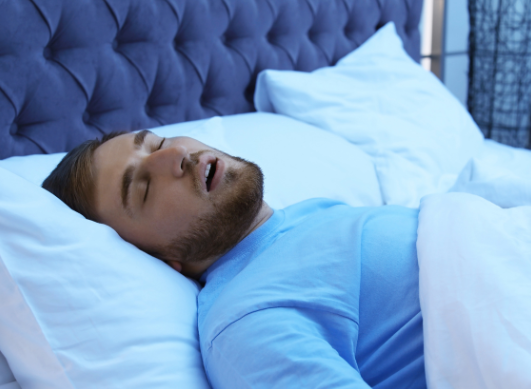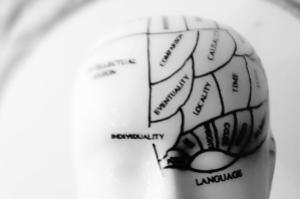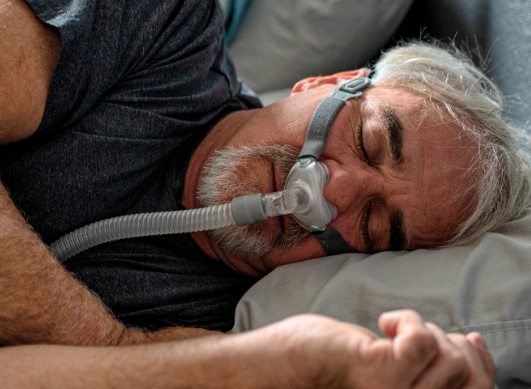What are the treatments for sleep apnoea?
Published 1 Mar 2024 • By Candice Salomé
Sleep apnoea, or obstructive sleep apnoea-hypopnoea syndrome (OSAHS), is a serious sleep disorder characterized by frequent and prolonged interruptions in breathing. This syndrome is due to repeated episodes of obstruction of the respiratory tracts in the back of the throat.
So what exactly is sleep apnoea? What are its causes and how does it affect those who suffer from it? How is it treated?
We explain it all in our article!

What is sleep apnoea?
Sleep apnoea is a serious sleep disorder characterised by frequent and prolonged interruptions in breathing, which disrupt sleep and lead to a decrease in the amount of oxygen and an increase in the level of carbon dioxide in the blood.
Sleep apnoea syndrome, also known as obstructive sleep apnoea-hypopnoea syndrome (OSAHS), is characterised by frequent and involuntary interruptions in breathing during sleep, or reduced respiratory flow.
What is the impact of sleep apnoea?
Sleep apnoea generally causes chronic fatigue. This fatigue is linked to micro-awakenings of which the patient is unaware, resulting in poor-quality sleep. This leads to episodes of sleepiness during the day, concentration problems and memory impairment. It also leads to cardiovascular complications, contributing to an increased risk of mortality.
What are the symptoms and stages of sleep apnoea?
The severity of sleep apnoea syndrome is measured by the number of apnoeas/hypopnoeas per hour of sleep. Doctors diagnose obstructive sleep apnoea (OSAHS) when the following situations occur:
- There is an interruption in breathing during sleep,
- The number of breathing interruptions is at least 5 per hour,
- Each interruption lasts for more than 10 seconds.
There are 3 stages of sleep apnoea, depending on the number of apnoeas/hypopnoeas per hour of sleep:
- Mild apnoea: between 5 and 15 interruptions,
- Moderate apnoea: between 16 and 30 interruptions,
- Severe apnoea: more than 30 interruptions.
What happens to the body during sleep apnoea?
Sleep apnoea syndrome is characterised by recurrent obstruction of the air passage in the pharynx, lasting 10 to 30 seconds, sometimes longer, and occurring at least 5 times per hour of sleep.
Obstructive sleep apnoea occurs when the air passage is obstructed by a physical obstacle such as the soft part of the palate, the tongue or the tonsils.
This phenomenon may also be due to relaxation of the muscles in the walls of the pharynx, or to inadequate muscle coordination during the inspiration/expiration cycle.
What are the risk factors for sleep apnoea?
Obstructive sleep apnoea affects men twice as often as women.
It is often linked to excess weight, frequently associated with metabolic syndrome or diabetes, and its prevalence increases with age, affecting more than 30% of individuals over the age of 65.
Sleep apnoea can also be the cause of enlarged tonsils and vegetations obstructing the airways. This is mostly found in children aged between 2 and 6 suffering from obstructive sleep apnoea. Obesity also significantly increases the risk of sleep apnoea in children and adolescents.
Central sleep apnoea is much rarer. It results from a dysfunction of respiratory control located in the region of the brain known as the brainstem. In this case, the brainstem does not react appropriately to fluctuations in carbon dioxide, leading to interruptions in breathing or breathing that is shallower and slower than normal. Possible causes include conditions such as stroke and heart failure.
How is sleep apnoea diagnosed?
Diagnosis of sleep apnoea is based on sleep recordings made in a specialised centre, which allow to measure the number of apnoeas/hypoapnoeas per hour of sleep.
There are 2 types of examination:
- Nocturnal ventilation polygraphy, which involves recording the patient's breathing for at least six hours and measuring their blood oxygenation with an oximeter.
- Polysomnography, a more complete examination that records the electrical rhythms coming from the body in order to detect the stages of sleep. This test provides more precise information about the severity of sleep apnoea syndrome.
What are the treatments for sleep apnoea?
The most often recommended treatment for sleep apnoea is using continuous positive airway pressure (CPAP).
CPAP is a machine that works as follows: during the night, pressurised air is administered through a mask placed over the nose, keeping the airways open. It is not a very convenient device, as, to be effective, it must be worn for at least 5 hours a night. However, when the device is used correctly, it reduces the risk of mortality and cardiac incidents and improves daytime alertness.
Continuous positive airway pressure (CPAP) at night is recommended for patients with more than 30 apnoeas per hour identified via sleep recording, or if the patient has between 15 and 30 apnoeas per hour, but the impact of the condition on their daily life is too significant: drowsiness during the day, fatigue or headaches in the morning. The presence of serious cardiovascular disease may also be a reason for using CPAP.
Severe snoring on a daily basis, with the feeling of suffocation, is also one of the symptoms that may justify the use of CPAP.
There also exists an alternative oral device, called a mandibular advancement orthosis. It was designed to keep the lower jaw (mandible) in a slightly forward position. The device is custom-made and works by forcing the tongue forward, thus facilitating the passage of air into the pharynx.
For cases of sleep apnoea in children when it is caused by enlarged tonsils, treatment often involves removing the tonsils.
Surgery is also sometimes used in adults when the cause of apnoea is linked to an anatomical defect (removing the tonsils or uvula, modifying the anatomy of the pharynx, nasal surgery, jaw surgery, etc.). These procedures are obviously not without risk and should only be used as a last resort.
When sleep apnoea causes daytime sleepiness that is not well-managed, even with recommended treatments such as continuous positive airway pressure (CPAP), solriamfetol (Sunosi®) is a possible alternative. However, it is reserved for patients who are already receiving primary treatment for their obstructive sleep apnoea and whose sleepiness has not been treated. However, it is important to know that this medication is contraindicated in people with a history of cardiovascular disease.
Take care!
Sources :
Apnée du sommeil, Le Manuel Merck
Comment soigne-t-on l’apnée du sommeil ?, Vidal
Apnée du sommeil, Inserm
SUNOSI (solriamfetol), HAS
La machine à pression positive continue (PPC), Alliance Apnées du Sommeil
Ablation chirurgicale des amygdales linguales dans le traitement du syndrome d’apnées obstructives du sommeil, C. Mure, M. Blumen, L. Page, F. Chabolle
Comments
You will also like

Fighting schizophrenia symptoms: a long journey against paranoia after detainment and denial
12 Dec 2018 • 7 comments

 Facebook
Facebook Twitter
Twitter

